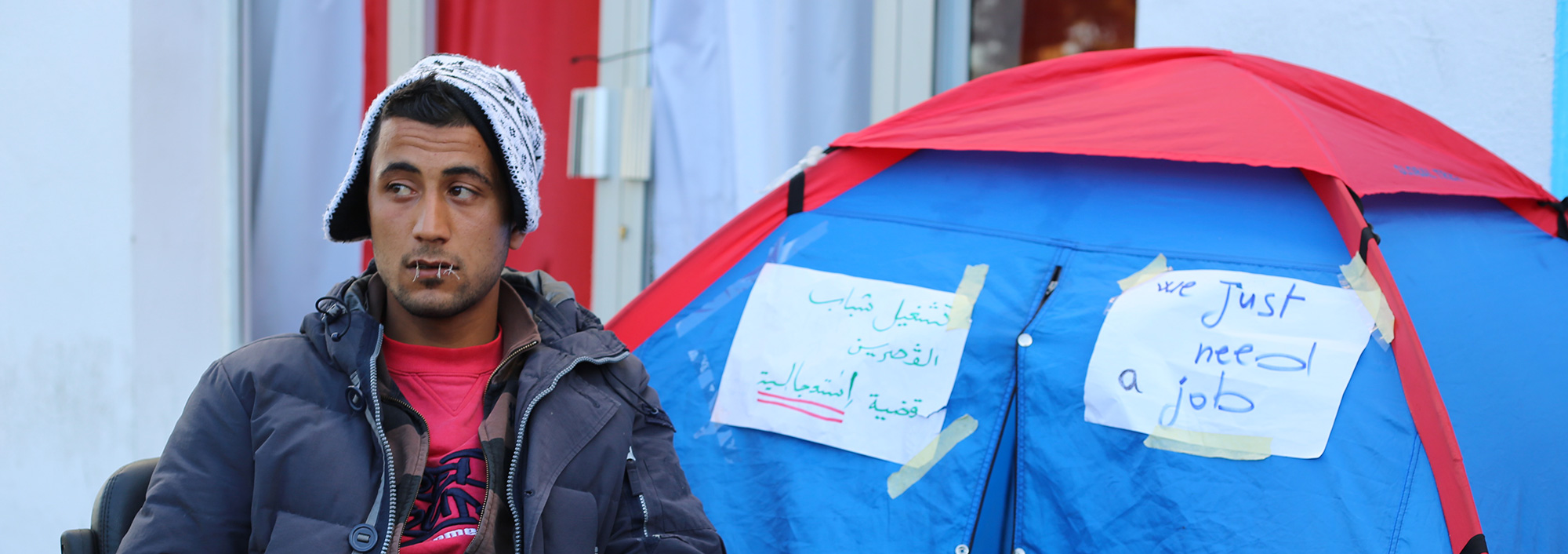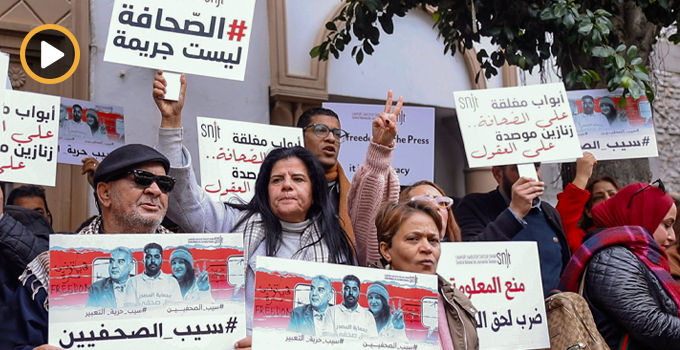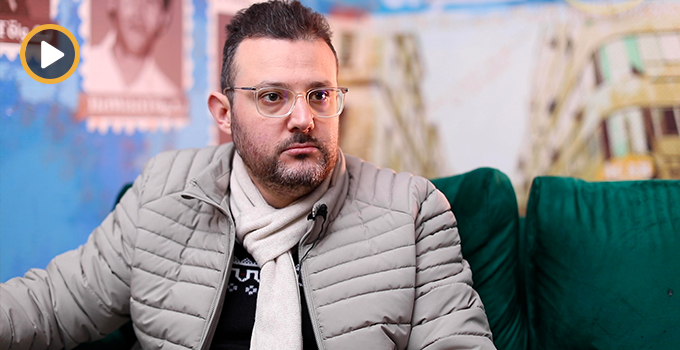Following the death of a young police officer in Kasserine on January 20, the government’s response to social movements across the country recalls the old tendencies of a police state. While citizens and local authorities in a few regions have undertaken negotiations for employment and development, the government has yet to respond to protesters’ demands with a comprehensive strategy or solution. Instead, a union of the National Guard is implicated in the diffusion of fabricated images portraying violent protests, and police forces have begun to arrest young activists accused of “disrupting public order.”

From media silence to a rhetoric of violence
On Sunday, January 31, secretary general for the National Guard Sami Knaoui appeared on television for the second week in a row concerning pictures of demonstrators that had been posted on Facebook. Asked about the diffusion of two photographs which had been uncovered as a hoax, Knaoui admitted that the images had been released by a union of the National Guard and were not associated with the Interior Ministry.
The images were among several which have surfaced on social media networks since January 21. Following an initial blackout in mainstream news coverage of demonstrations, media reports of peaceful protests turned into slander campaigns based on fabrications.
I live in Kasserine. Some boys attacked me. I passed out and found myself amidst stones and tear gas. I fell and was suffocated. Some boys took me and sexually assaulted me, one of them cut me with a knife.
On Thursday, January 21, the image of a young women, her face scraped and swollen, appeared online with the above text. The post, published on the Facebook account of a certain Marwa S., appeared one day after the death of a young police officer in Kasserine and has since been traced to the National Guard; the source of the image is a video of Miryam, a Moroccan woman and victim of marital violence.
The same night, the first violent demonstration erupted in the neighborhood of Ettadhaman in Tunis, where buildings were vandalized and businesses pillaged. A video of the scene shows streets curiously void of security forces and overtaken by looters. By Friday, media coverage of protests employed new terms to describe demonstrators (“troublemakers,” “thieves,” “bandits”), and several more images emerged—fabricated photographs which portray protesters in the act of looting or posing with weapons.

Many will recall the propagation of similar falsifications five years ago when Tunisians marched the streets chanting the same slogans that can be heard today. Then as now, rumors originating among the ranks of security forces are concocted to justify forceful intervention and brutality.
In a climate of uncertainty and fear created by troublemakers, such lies prove to be a powerful tool to discredit the movement underway and break the bond of solidarity that serves the social movement. Sofiane Bel Haj, Social protests: online hoaxes–virtual teargas
Police crackdown on peaceful protests
Ten days after protests began in Kasserine, such forceful intervention has sought to repress what has been, in its vast majority, a peaceful movement. Nine individuals have been arrested and dozens taken in for questioning by the police.

Arrests began on Sunday January 24 following peaceful demonstrations in Fahs, Bir Mcharguia, Zaghouan center, Nadhour, and Hebas (Zaghouan). Accused of “forming a criminal gang and inciting disorder,” six youth (Mohamed Amine Gharbi, Hamdi Souli, Ami Ben Ahmed, Abdelhak Mehathbi, Chaker Akili and Ramzi Kanzari) are being held in police custody.
The young protesters confirm that “the demonstrations were peaceful and monitored by civil society. The youth arrested by police are on a committee that negotiated with local officials. We have videos proving that they were working to calm tensions between police and demonstrators,” explains Sabri Ben Slimane, member of the protest movement in the governorate of Zaghouan (184 kilometers from Tunis).
The movement in Zaghouan began on January 20 when protesters gathered in the industrial zone demanding jobs for the region’s youth and an end to the practices of nepotism and favoritism. “The movement grew and we succeeded in setting up a meeting with the regional delegate and regional representatives of the UGTT, UTICA, the Tunisian Solidarity Bank in order to open negotiations concerning employment, agricultural loans, and regional development,” explains Houssem Bouguerass, a young civil society activist.
Although an agreement had been signed by residents and local authorities in Kerkennah (306 kilometers from Tunis) to commence employment negotiations, protesters were surprised by police aggression to break up protests; on January 28, sit-inners were arrested by police under the pretext of disturbing the public order. Two days before the arrests, the Union of Unemployed Graduates (UDC) had issued a statement confirming that the governor of Sfax cancelled a meeting planned for Friday, February 5. Member of the local UDC office, Ahmed Souissi, explains however that negotiations had been underway with the governor of Sfax and Kamel Jendoubi, minister of Constitutional Authorities and Civil Society. “This return to security solutions and repression prove that the government does not have solutions to propose for development and employment issues,” says Souissi.
Forceful intervention has also been the tactic to quell demonstrations in Jendouba (154 kilometers from Tunis), where law enforcement stepped in to disperse sit-inners gathered before governorate headquarters late in the night on January 25. The regional office of the Tunisian League for Human Rights (LTDH) denounced police violence and aggressions against protesters, one of whom was transported to the hospital. The following day, residents re-occupied governorate headquarters denouncing police aggression. According to the latter, local authorities have refused “any form of dialogue with inhabitants.”
In Ghar Dimaou on January 25, eyewitnesses confirmed that protesters apprehended by police were being held inside the delegation while security forces blocked access to the sit-in. Unemployed individuals and skilled workers continue their sit-in at delegation headquarters.
In Kasserine, where the wave of protests began following the death of Ridha Yahyaoui, youth have found themselves accused of theft. January 26 and 27, civil society activists Hamza Saihi, Sadek Sassi and Nooman Mhamdi were taken in for questioning, accused by police of inciting violence and disorder. In 2015, Saihi was part of a group that campaigned against opacity and delays in a renovation project for the city’s Martyrs memorial garden.
“During our campaign, we gathered in front of the garden and some individuals removed the corrugated metal as a gesture of protest against the municipality’s poor management,” explains Hamza, still surprised to see his name among those accused of inciting violence. “A bailiff observed our gathering to prove that nothing was destroyed or stolen during our peaceful demonstration.”
On Saturday, January 23, activists Allala Mastouri and Samer Bouyaha were arrested in Deguech (Tozeur, 450 kilometers from Tunis), and a wanted notice was issued for activist Ahmed Taheri. The three were accused of having participated in the vandalism and pillaging which took place two days earlier. UDC member Ammar Msatra who is on a hunger strike since last Wednesday, confirms that Tozeur’s delegate had called upon civil society on January 28 to “keep watch over young demonstrators and protect public institutions from troublemakers. The three activists accused are among those who risked their lives to help police protect public institutions.”
Msatra reports that a police station was burned, and that two administrative buildings and an association for the handicapped were robbed. “The day following the events authorities began to apprehend youth who had protected the city, under the pretext of public disorder.” Pressured by civil society and the LTDH in particular, Allal Mastouri and Samer Bouyahha were released on January 28.





iThere are no comments
Add yours